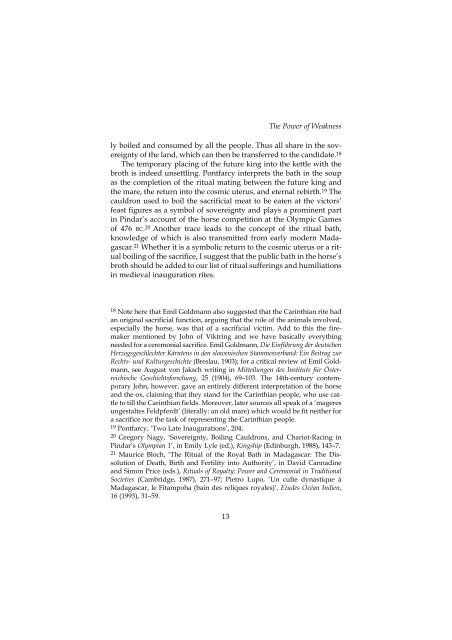The Power of Weakness: Machiavelli Revisited - German Historical ...
The Power of Weakness: Machiavelli Revisited - German Historical ...
The Power of Weakness: Machiavelli Revisited - German Historical ...
You also want an ePaper? Increase the reach of your titles
YUMPU automatically turns print PDFs into web optimized ePapers that Google loves.
ly boiled and consumed by all the people. Thus all share in the sovereignty<br />
<strong>of</strong> the land, which can then be transferred to the candidate. 18<br />
<strong>The</strong> temporary placing <strong>of</strong> the future king into the kettle with the<br />
broth is indeed unsettling. Pontfarcy interprets the bath in the soup<br />
as the completion <strong>of</strong> the ritual mating between the future king and<br />
the mare, the return into the cosmic uterus, and eternal rebirth. 19 <strong>The</strong><br />
cauldron used to boil the sacrificial meat to be eaten at the victors’<br />
feast figures as a symbol <strong>of</strong> sovereignty and plays a prominent part<br />
in Pindar’s account <strong>of</strong> the horse competition at the Olympic Games<br />
<strong>of</strong> 476 BC. 20 Another trace leads to the concept <strong>of</strong> the ritual bath,<br />
know ledge <strong>of</strong> which is also transmitted from early modern Mada -<br />
gascar. 21 Whether it is a symbolic return to the cosmic uterus or a ritual<br />
boiling <strong>of</strong> the sacrifice, I suggest that the public bath in the horse’s<br />
broth should be added to our list <strong>of</strong> ritual sufferings and humiliations<br />
in medieval inauguration rites.<br />
13<br />
<strong>The</strong> <strong>Power</strong> <strong>of</strong> <strong>Weakness</strong><br />
18 Note here that Emil Goldmann also suggested that the Carinthian rite had<br />
an original sacrificial function, arguing that the role <strong>of</strong> the animals involved,<br />
especially the horse, was that <strong>of</strong> a sacrificial victim. Add to this the firemaker<br />
mentioned by John <strong>of</strong> Viktring and we have basically everything<br />
need ed for a ceremonial sacrifice. Emil Goldmann, Die Einführung der deu t schen<br />
Herzogsgeschlechter Kärntens in den slowenischen Stammesverband: Ein Bei trag zur<br />
Rechts- und Kulturgeschichte (Breslau, 1903); for a critical review <strong>of</strong> Emil Gold -<br />
mann, see August von Jaksch writing in Mitteilungen des Instituts für Österreichische<br />
Geschichtsforschung, 25 (1904), 69–103. <strong>The</strong> 14th-century con tem -<br />
porary John, however, gave an entirely different interpretation <strong>of</strong> the horse<br />
and the ox, claiming that they stand for the Carinthian people, who use cattle<br />
to till the Carinthian fields. Moreover, later sources all speak <strong>of</strong> a ‘mageres<br />
ungestaltes Feldpferdt’ (literally: an old mare) which would be fit neither for<br />
a sacrifice nor the task <strong>of</strong> representing the Carinthian people.<br />
19 Pontfarcy, ‘Two Late Inaugurations’, 204.<br />
20 Gregory Nagy, ‘Sovereignty, Boiling Cauldrons, and Chariot-Racing in<br />
Pindar’s Olympian 1’, in Emily Lyle (ed.), Kingship (Edinburgh, 1988), 143–7.<br />
21 Maurice Bloch, ‘<strong>The</strong> Ritual <strong>of</strong> the Royal Bath in Madagascar: <strong>The</strong> Dis -<br />
solution <strong>of</strong> Death, Birth and Fertility into Authority’, in David Cannadine<br />
and Simon Price (eds.), Rituals <strong>of</strong> Royalty: <strong>Power</strong> and Ceremonial in Traditional<br />
Societies (Cambridge, 1987), 271–97; Pietro Lupo, ‘Un culte dynastique à<br />
Madagascar, le Fitampoha (bain des reliques royales)’, Etudes Océan Indien,<br />
16 (1993), 31–59.













